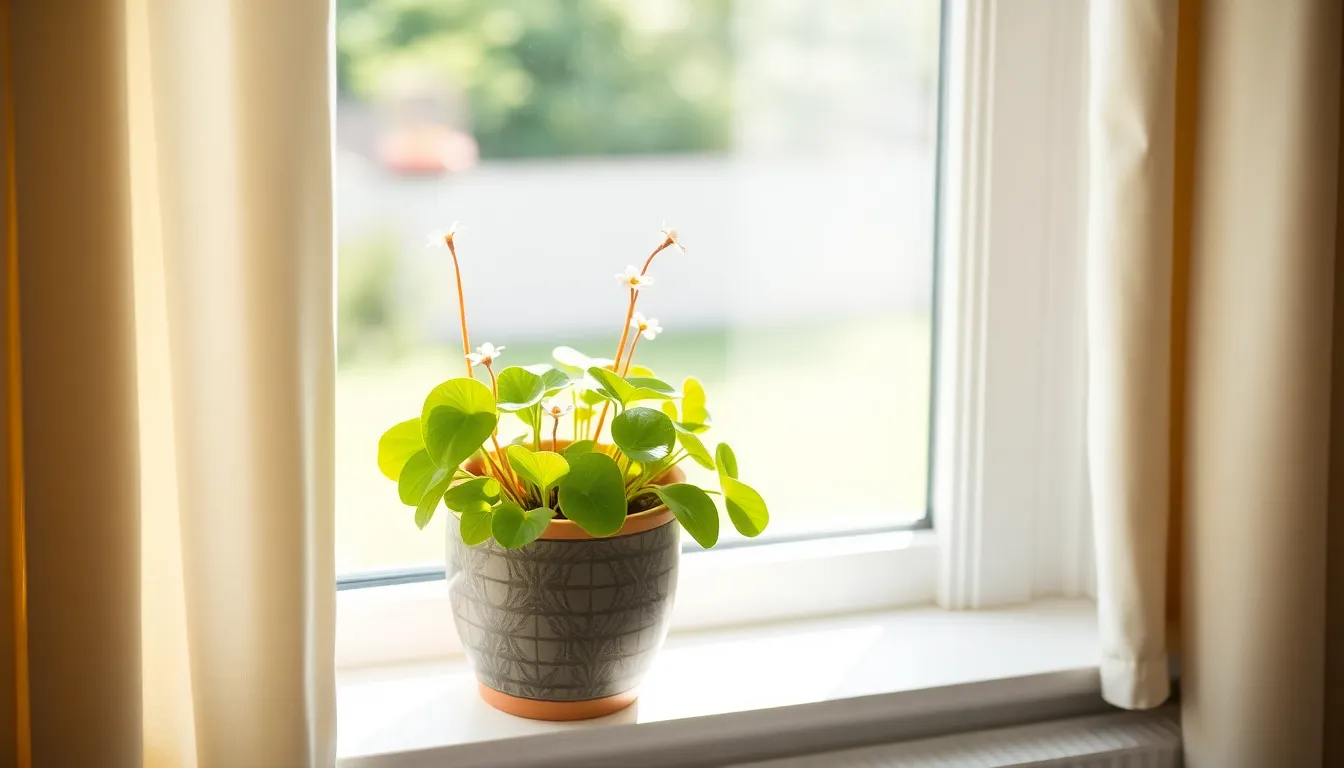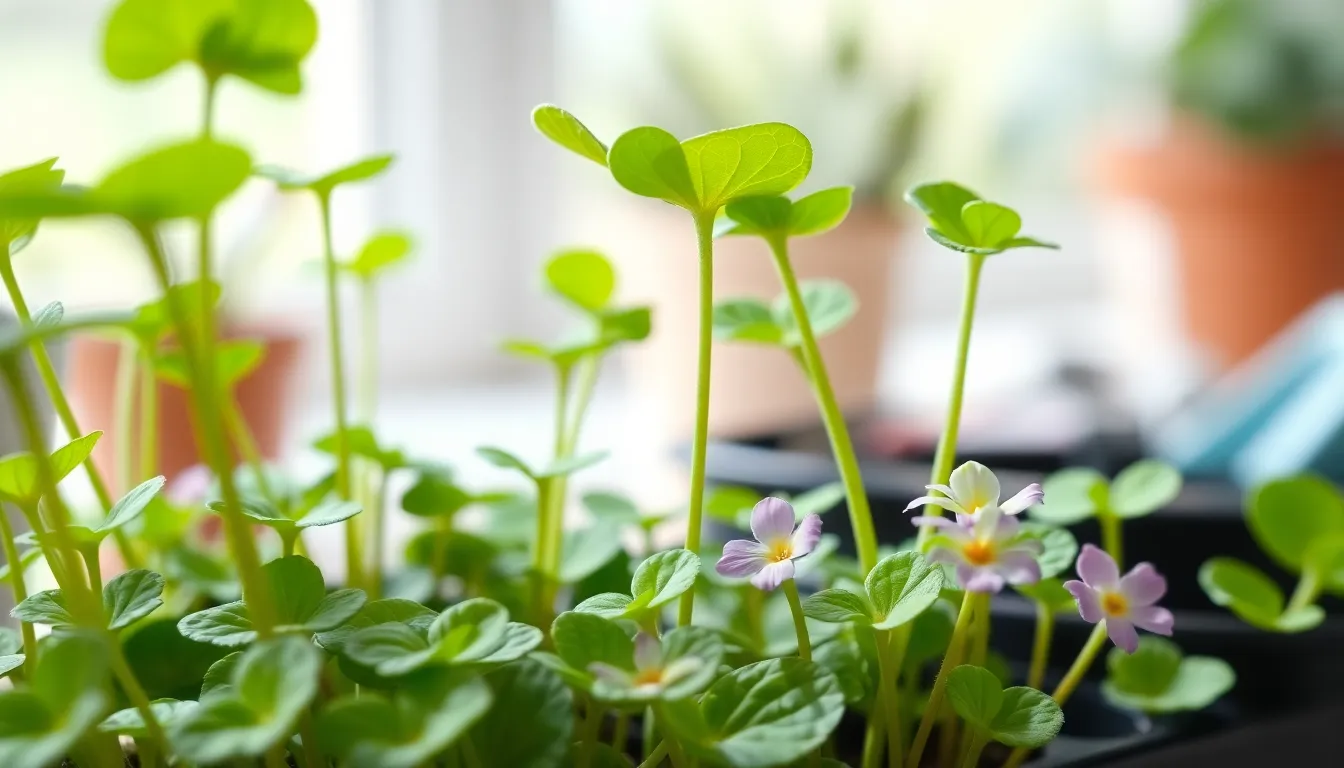If you’ve ever laid eyes on an oxalis plant, you know it’s a little green wonder that can brighten up any room. With its charming clover-like leaves and delicate flowers, this plant isn’t just a pretty face; it’s also a low-maintenance superstar that even the busiest plant parents can handle. Who knew that having a green thumb could be so easy?
Oxalis Plant Care
Oxalis plants, commonly known as shamrock plants, feature distinct clover-like leaves and small flowers that add charm to gardens and homes. These plants include over 500 species, showcasing a diverse array of colors and leaf shapes. Low-maintenance properties make Oxalis ideal for novice gardeners and seasoned plant lovers alike.
Light requirements for Oxalis can vary based on species. Many thrive in bright, indirect sunlight, while some can tolerate partial shade. It’s essential to avoid direct sunlight, which may scorch the leaves. Well-draining soil promotes healthy growth. A mix that retains some moisture yet allows excess water to escape works best.
Watering practices play a critical role in Oxalis care. These plants prefer slightly dry conditions between watering sessions. Overwatering can lead to bulb rot, so it’s vital to allow the soil to dry fully before the next watering. Fertilization isn’t necessary, but a balanced liquid fertilizer can support growth during the active season.
Temperature preferences are moderate. Oxalis thrives in temperatures ranging from 60°F to 75°F. Sudden temperature fluctuations may stress the plant, so maintaining a stable environment benefits its health.
Pest issues may arise, although Oxalis is generally pest-resistant. Regularly checking the leaves for signs of aphids or spider mites helps prevent infestations. Addressing any pest problems promptly ensures the plant remains healthy.
Propagation methods for Oxalis can involve division or seeds. Dividing bulbs during dormancy supports new plant growth. Seeds can be sown in spring for those looking to expand their collection. A little care aids in nurturing these delightful plants, making them a great addition to any collection.
Essential Care Requirements


Caring for the oxalis plant involves understanding its specific needs to thrive indoors or outdoors. Focus on light, water, and soil to ensure optimal growth.
Light Conditions
Bright, indirect sunlight serves oxalis plants best. They thrive under these conditions, promoting healthy leaf development and vibrant flowers. Some species adapt to partial shade, making them versatile options for various environments. Direct sunlight, however, can lead to leaf scorch, damaging the plant. Placing them near a window with filtered light often proves beneficial.
Watering Needs
Slightly dry conditions between watering promote healthy growth for oxalis plants. Overwatering leads to bulb rot, harming the plant’s roots. Water the soil thoroughly, then allow it to dry out before the next feeding. During the active growing season, most oxalis species require watering once the top inch of soil feels dry. Adjust frequency based on humidity levels and season to ensure consistent hydration.
Soil Type
Well-draining soil remains essential for oxalis plants. Utilize a mix designed for houseplants or create a blend with perlite and potting soil. This combination provides adequate aeration while retaining some moisture. Soil pH levels around 6.0 to 7.0 support optimal growth. Regularly checking soil moisture helps maintain balance, ensuring that the bulbs thrive without the risk of rot.
Common Oxalis Varieties
Oxalis plants come in various species, each with unique traits. Understanding these common varieties enhances care practices and appreciation for their beauty.
Oxalis Triangularis
Oxalis triangularis, often called the purple shamrock, is renowned for its striking purple leaves and delicate white or pink flowers. This variety thrives in bright, indirect light, making it perfect for homes with ample natural light. While it enjoys slightly moist soil, overwatering leads to bulb rot. A well-draining potting mixture helps maintain the right moisture level. During dormancy, oxalis triangularis sheds its leaves, signaling a rest period but not indicating plant death. Regular checks for pests ensure it remains healthy and vibrant.
Oxalis Regnellii
Oxalis regnellii, known as the green shamrock, features lush green leaves and appears as a popular houseplant. Its vibrant foliage requires similar light conditions, favoring bright, indirect sunlight. The soil should remain slightly dry between waterings, as this prevents bulb rot. Fertilizing during the growing season encourages healthy development. This species can produce small, attractive flowers, adding to its appeal. Pests like aphids may occasionally pose a threat, necessitating vigilance in inspection and care.
Pest and Disease Management
Monitoring oxalis plants for pests and diseases ensures a healthy growing environment. Common pests include aphids, spider mites, and mealybugs, which can harm the foliage and overall plant vitality. Regularly inspecting both the leaves and soil allows for early detection and treatment.
Addressing pest infestations often involves a few options. Insecticidal soap effectively targets soft-bodied insects. Neem oil serves as a natural pesticide, disrupting the life cycle of pests. If dealing with a heavy infestation, insecticidal powder may provide a stronger solution.
Understanding the signs of disease helps prevent significant damage. Fungal infections often manifest as leaf spots or rot. These conditions thrive in overly damp environments, so maintaining proper soil moisture is essential. Ensuring good air circulation also minimizes disease risk.
Schedule routine checks for any discoloration or unusual growth patterns to identify potential issues quickly. Taking immediate action at the first sign of trouble limits the spread of pests or diseases. Avoiding overwatering promotes a healthier root system, reducing the chance of fungal issues.
Fertilization affects both growth and health. Using balanced fertilizers at recommended intervals strengthens plant resilience. Healthy plants naturally resist pests and diseases more effectively, enhancing overall vitality.
Overall, keeping an eye on oxalis plants allows for timely management of pests and diseases. With vigilance and proper care techniques, maintaining vibrant and healthy plants becomes a straightforward task.
Tips for Successful Growth
Providing optimum light conditions is crucial for oxalis. Many varieties thrive in bright, indirect sunlight, while some tolerate partial shade. Avoid direct sunlight to prevent leaf scorching, which can damage the plant.
Watering practices play a vital role in oxalis care. It’s important to allow the soil to dry slightly between waterings to prevent bulb rot. Monitoring soil moisture ensures the plant receives adequate hydration without becoming waterlogged.
Using well-draining soil also enhances growth potential. A mix designed for houseplants or a combination of potting soil and perlite is ideal. Soil pH levels between 6.0 and 7.0 support healthy development and root function.
Fertilizing oxalis can boost growth during the active season. Balanced liquid fertilizers applied at recommended intervals provide essential nutrients without overwhelming the plants. Fertilization isn’t necessary during dormancy.
Temperature preferences affect the overall health of the plant. Oxalis thrives best in environments between 60°F and 75°F. Maintaining a stable temperature range encourages continuous growth and blooming.
Regular pest inspections should not be overlooked. Checking for pests like aphids and spider mites allows for early detection and management. Employing insecticidal soap or neem oil proves effective in treating infestations.
Understanding disease signs is beneficial for prevention. Leaf spots or root rot often indicate overly damp conditions. Ensuring good air circulation and proper soil moisture dramatically reduces disease risk.
Dividing bulbs during dormancy serves as an effective propagation method. Sowing seeds in spring captures the best growth period. Expanding a collection of oxalis can lead to a vibrant display of these charming plants.




